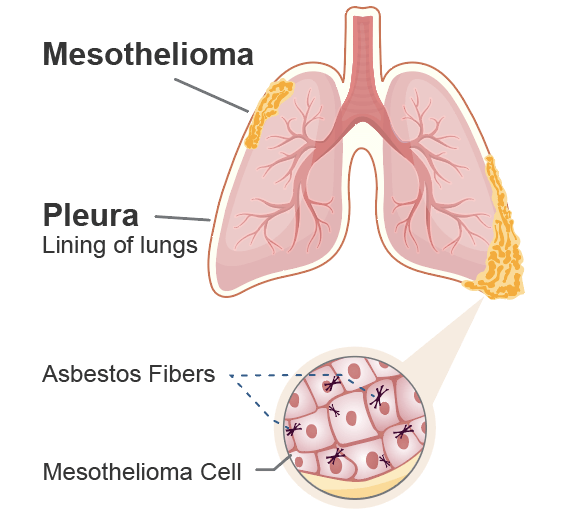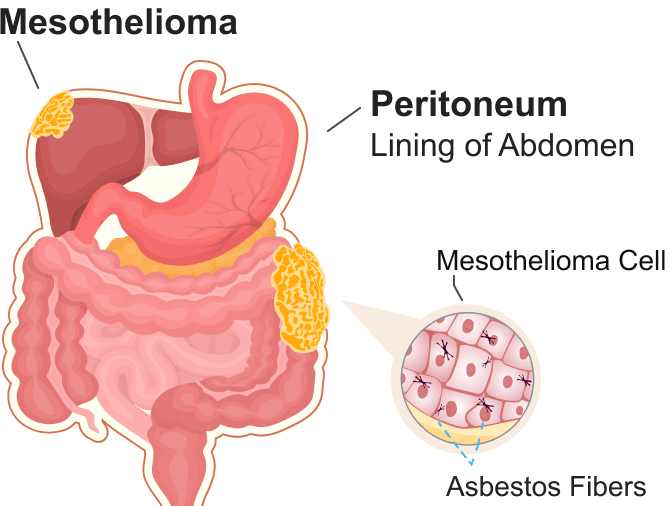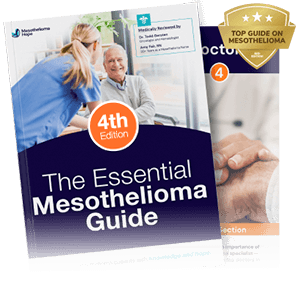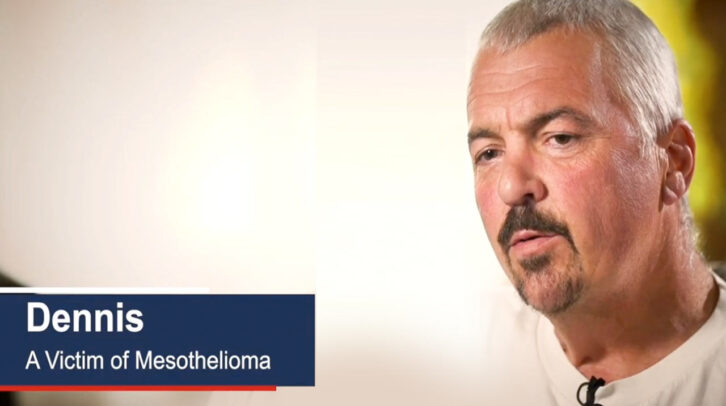What Is Mesothelioma?
Malignant mesothelioma is a form of cancer caused by asbestos exposure that most commonly develops in the lining of the lungs, known as the pleura.
Mesothelioma cancer can also affect the lining of the abdomen. In rare instances, tumors may develop in the lining of the heart or testes.
Key Facts on Malignant Mesothelioma
- About 3,000 Americans are diagnosed with mesothelioma each year.
- Patients typically report a gradual increase in symptoms like cough, shortness of breath, and fluid buildup.
- Veterans make up roughly 30% of all mesothelioma cases.
- Patients and family members may qualify for legal compensation averaging over $1 million.
Manufacturers of asbestos-containing products hid the link between asbestos and mesothelioma for decades to keep making profits. As a result, millions of civilian workers, military personnel, and their families were exposed to asbestos without knowing the risks.

“I was exposed to asbestos through Sheetrock® products, the mud, through gaskets in piping, through respirators. The cartridges and the filters had asbestos in them. All through my career.”
How Does Asbestos Exposure Cause Mesothelioma?
It takes 10 to 50 years after asbestos exposure for mesothelioma to develop.
The process includes four key stages:
- Exposure – When asbestos is disturbed, people may inhale or ingest fibers.
- Buildup – Asbestos fibers become lodged in the protective linings of organs and accumulate with repeated exposure.
- Damage – Asbestos fibers irritate healthy tissue and cause inflammation.
- Cancer – Over time, the irritation can cause cancerous tumors to form.
Anyone exposed to asbestos — directly or secondhand — is at risk of developing mesothelioma and other diseases like lung cancer or asbestosis later in life.
Get our Free Mesothelioma Guide to learn about common sources of asbestos exposure, signs and symptoms, and much more.
Malignant Mesothelioma Symptoms
The symptoms of mesothelioma can vary based on where the cancer forms in the body. However, there are some general mesothelioma symptoms that are common among patients.
These include:
- Abdominal pain and/or chest pain
- Fever
- Fluid buildup in the chest (pleural effusion)
- Fluid buildup in the abdomen (ascites)
- Loss of appetite
- Nausea and vomiting
- Night sweats
- Persistent cough
- Shortness of breath
- Weight loss
If the cancer is caught in the early stages, most patients experience mild and vague symptoms. Once the cancer starts to spread, more severe systemic symptoms (symptoms affecting the entire body) may appear.


“If you feel like you’re not getting better and that this is something new for you, it’s best to encourage your doctor to proceed with more testing.”
Types of Mesothelioma
Mesothelioma can manifest in four different types, each impacting a specific part of the body. Keep reading to get a better grasp of these mesothelioma types.
Pleural Mesothelioma (Lung Lining)


Malignant pleural mesothelioma forms in the lining of the lungs and chest wall. This type makes up over 75% of reported mesothelioma cases, according to the American Cancer Society (ACS).
Pleural mesothelioma is characterized by four stages. Early stages of mesothelioma typically mean the cancer is limited to the chest area and hasn’t spread to nearby lymph nodes. Later stages of pleural mesothelioma can spread to distant organs.
The staging of pleural mesothelioma helps doctors determine the type of treatment a patient will receive. Early stages are easier to treat with pleural mesothelioma surgery.
Contact us today to speak with one of our caring Patient Advocates and get the answers you need.
Peritoneal Mesothelioma (Abdominal Lining)


Peritoneal mesothelioma is the second most common type of this cancer, making up 10% to 15% of all cases, according to MD Anderson Cancer Center. This type of mesothelioma develops in the abdominal lining, also known as the peritoneum.
Because peritoneal mesothelioma doesn’t directly affect the heart or lungs unless it spreads, patients diagnosed with this type often have higher survival rates than those with pleural mesothelioma.
More than half of patients live at least 5 years after diagnosis if they undergo cytoreductive surgery with HIPEC (hyperthermic intraperitoneal chemotherapy), according to a 2022 article in the Journal of Clinical Haematology.
Pericardial Mesothelioma (Heart Lining)
Pericardial mesothelioma forms in the pericardium, which is the tissue surrounding the heart. This type of cancer makes up less than 1% of all mesothelioma cases and has a poor prognosis.
A 2021 study found that pericardial mesothelioma patients have an average life expectancy of 2 months.
Testicular Mesothelioma (Testicle Lining)
Testicular mesothelioma develops in the lining of the testes, also called the tunica vaginalis. Only 151 cases of testicular mesothelioma have been reported over the past 11 years. Despite it being a rare diagnosis, it is highly treatable.
According to a report published in the journal Environmental Health, the average life expectancy with testicular mesothelioma is 46.7 months.
The Four Stages of Mesothelioma Cancer
Mesothelioma progresses through four stages that doctors use to describe the severity and spread of a patient’s cancer. These stages range from early, localized disease (stages 1 and 2) to advanced cases impacting distant organs (stages 3 and 4).
All forms of mesothelioma have different levels of progression and spread, but pleural mesothelioma is the only type where doctors use an official staging system. Learn more about each of the four stages of malignant pleural mesothelioma below.


- Cancer has not yet spread beyond the lung lining.
- The average life expectancy is 21 months.
- Surgery is often indicated and may increase survival time by several months or years.


- Cancer has spread outside of the lung lining, possibly into nearby lymph nodes.
- The average life expectancy is 19 months.
- Surgery is often explored as a treatment option to help patients live longer.


- Cancer has spread into nearby tissues, organs, or lymph nodes.
- The average life expectancy is 16 months.
- Treatments focus on slowing disease spread and managing pain.


- Cancer has invaded distant parts of the body.
- The average life expectancy is 12 months.
- Palliative (pain-relieving) care can help patients who aren’t eligible for treatment.
Although the above data points represent medical averages, there are always exceptions to the rule. One patient, John Stahl, was diagnosed with stage 4 pleural mesothelioma in 2019. He underwent treatment and is now back to living an active lifestyle.
How Do I Know If I Have Mesothelioma?
You can confirm whether you have mesothelioma by making an appointment with a specialist for a diagnosis.
Mesothelioma doctors take the following steps to diagnose this cancer:
- Physical exam: Patients complaining of possible mesothelioma symptoms should get a physical and tell their doctor about prior asbestos exposure.
- Imaging tests: Doctors will order chest X-rays, computed tomography (CT) scans, and/or magnetic resonance imaging (MRI) to look for signs of mesothelioma, like pleural thickening and fluid around the lungs.
- Biopsy: A biopsy is the only way to confirm a diagnosis of mesothelioma. During a biopsy, a pathologist examines a fluid/tissue sample under a microscope to see if it contains malignant (cancerous) mesothelial cells.
Find mesothelioma specialists who can confirm a diagnosis with our Free Doctor Match.
Nearly 1 in 4 Mesothelioma Cases Is Misdiagnosed
Since mesothelioma is so rare, it’s often misdiagnosed as pneumonia or lung cancer. In fact, a study published in Open Epidemiology Journal stated that 22.6% of pleural mesothelioma cases are misdiagnosed.
Mesothelioma misdiagnosis prevents patients from getting the right treatments and gives the disease more time to spread. Requesting a second opinion allows another specialist to review your CT scans and biopsy results and make sure the original diagnosis is accurate.


“Because mesothelioma is such a rare cancer, it’s common for the diagnosis to either not be established the first time, or to be the wrong diagnosis because it can look like other diseases.”
Even if you’ve been given a different diagnosis, it’s important to consider getting a second opinion if you suspect your symptoms may be related to asbestos exposure.
In addition to misdiagnosing this cancer altogether, doctors who aren’t specialized in mesothelioma may not correctly determine your cancer stage, cell type, or other factors that can influence treatment. Once your diagnosis has been confirmed, you can work with your doctor to determine the best course of treatment.
Mesothelioma Prognosis
Mesothelioma prognosis refers to the expected outcome or outlook for patients diagnosed with this cancer, including their life expectancy.
Factors that may affect your prognosis include:
- Age and overall health
- Cancer stage and location
- Cell type
- Treatment response
Prognosis is just an estimate based on the past results of other mesothelioma patients. Everyone’s situation is unique, and your prognosis can improve depending on how your body responds to treatment.
Some patients have exceeded their initial prognosis by months, years, and even decades. These mesothelioma survivors have defied expectations and are still living fulfilling lives with the people they love.
Life Expectancy and Survival Rate
Mesothelioma life expectancy and survival rate are essential terms for patients to understand when getting a diagnosis.
- Life expectancy is the estimated length of time a person diagnosed with mesothelioma can expect to live. It’s typically given in months or years. The average life expectancy with mesothelioma is 12-21 months.
- Survival rate represents the percentage of patients still alive a certain period after their mesothelioma diagnosis. It’s often expressed as a percentage over 1, 5, or 10 years. The overall 5-year survival rate for mesothelioma is 12%, according to the ACS.
Get your Free Mesothelioma Guide to learn more about prognosis, survival rate, and how you can improve your life expectancy.
John’s Story of Pleural Mesothelioma Survival


John Stahl received a stage 4 pleural mesothelioma diagnosis in 2019 after being exposed to asbestos for decades over his long career in the construction industry.
Despite this daunting diagnosis, John has not let mesothelioma define his life. With the unwavering support of his wife, Dee, he has navigated a challenging treatment regimen of chemotherapy while maintaining a positive outlook.
“I’m doing very well, as a matter of fact. I play golf twice a week. I ride my side-by-side. I go hang out with my friends when they’re around. Yeah, I’m pretty well back to normal.”
– John Stahl, 4+ year pleural mesothelioma survivor
John’s survival story serves as a ray of hope for other patients fighting advanced mesothelioma, showing that with resilience, the right medical care, and a strong support system, it’s possible to build a fulfilling and happy life.
Julie’s Story of Peritoneal Mesothelioma Survival


Julie Gundlach’s mesothelioma journey began unexpectedly when, at age 35, she was diagnosed with peritoneal mesothelioma caused by secondhand asbestos exposure. Doctors said she had 6-12 months to live.
Her love for her daughter Madeline helped Julie stay strong during her many surgeries and chemotherapy treatments. For over 17 years, Julie has embraced each day, one moment at a time.
“You look back on doing that one-day-at-a time thing, and all of a sudden you realize that you’ve accumulated a lot of days.”
– Julie Gundlach, 17+ year peritoneal mesothelioma survivor
Julie uses her experience with mesothelioma to raise awareness about the dangers of asbestos and help others affected by this cancer. She’s been an outspoken advocate for a nationwide asbestos ban and participates in events like the annual Miles for Meso run/walk fundraiser for mesothelioma research.
Treatment Options for Malignant Mesothelioma
All patients can benefit from mesothelioma treatment in some way, whether to potentially increase their life expectancy or reduce symptoms. Which treatments will work best depends on many patient health factors, such as the type and stage of their cancer.
These treatment methods include:
- Chemotherapy can be used as a standalone treatment or combined with surgery to kill remaining cancer cells. Patients usually receive chemotherapy in cycles over several weeks or months.
- Clinical trials are constantly testing newer treatments like targeted therapy and cancer vaccines to see if they can help mesothelioma patients live longer.
- Immunotherapy works by boosting the body’s immune system to target mesothelioma cells. Opdivo® (nivolumab) and Yervoy® (ipilimumab) are the two immunotherapy drugs currently approved for mesothelioma.
- Palliative care helps patients manage pain and improve their quality of life. Palliative treatments are often used throughout a patient’s diagnosis.
- Radiation therapy uses high-energy beams to damage the DNA of cancer cells and shrink cancerous tumors.
- Surgery for mesothelioma is performed with the goal of removing tumors and any surrounding tissue affected by the cancer.
- Tumor Treating Fields are adhesive patches that are attached to the chest and generate electricity. The electrical waves disrupt mesothelioma’s ability to spread. This treatment has few side effects and is combined with chemotherapy.


“When hope is part of the equation, anything is possible, so people should be encouraged to seek treatment.”
Top Mesothelioma Doctors
Mesothelioma doctors have the medical experience and knowledge needed to effectively treat this cancer. Seeking a second opinion from one of these specialists after your diagnosis is the best way to potentially expand your treatment options and improve your prognosis.
Top mesothelioma doctors are uniquely equipped to:
- Build a personalized cancer care plan that includes the most effective treatments
- Determine your eligibility for emerging treatments and clinical trials
- Answer questions as you move forward with treatment
- Collaborate closely with other members of your medical team
- Help you and your loved ones make informed health care decisions
There are hundreds of qualified doctors working at mesothelioma cancer centers nationwide who not only treat patients but also supervise clinical trials and conduct their own cancer research.
Find top specialists who can help diagnose and treat you now with our Free Doctor Match.
Financial Support for Patients and Families
It can be challenging to maintain financial stability after a mesothelioma diagnosis because of the high costs of treating this cancer. Patients who face financial concerns often experience added stress that diverts their attention from healing and spending cherished moments with family and friends.
Fortunately, there are options for compensation that can help patients cover medical costs and out-of-pocket expenses.
Mesothelioma patients and their families can pursue financial assistance from:
- Asbestos trust funds: Dozens of asbestos companies have already set aside over $30 billion in compensation for mesothelioma victims as part of bankruptcy proceedings.
- Mesothelioma lawsuits: Lawsuits allow victims and families to pursue compensation from the asbestos companies responsible for their illness. The average settlement from a mesothelioma lawsuit awards between $1 million and $1.4 million.
- VA benefits: Married veterans with mesothelioma may qualify for nearly $4,000 a month in disability compensation if they were exposed to asbestos during their military service.
Mesothelioma victim Dennis talks about his journey from diagnosis to filing an asbestos claim for help pay for treatment. Call us today at (866) 608-8933 to take the first step toward getting compensation for mesothelioma. View Transcript.
Duration: 2 min 48 sec
The specialist called me one night at 5:30 and I thought, “this is odd time for them to be calling me.”
He said, “Dennis, I have the results for your test.”
And my reaction was, “Oh, good. What do you got?”
He didn’t speak for like five or seven seconds and I thought, “Oh my god, this is it.”
And he said, “The results from the biopsy are you have mesothelioma, you’ve been around asbestos.”
They determined I had peritoneal mesothelioma, that means it’s mostly in my stomach.
I asked her, “How long am I going to live, doctor?”
She told me, “I see five to ten years and I will hope for ten to fifteen.”
So I thought, “Oh my god, I just lose my dad three months earlier, now I got cancer.”
I had fun being a mechanic. The dust from brake jobs, yeah there’s a lot, especially in the hub of the wheel; got to get all the dust away so you can put in the new stuff.
I knew there was asbestos in it but I didn’t know it was harmful. I didn’t know it would cause cancer.
Do I call the attorneys? I didn’t know I would get these benefits. It’s helped complete our – make our living financially, we would have been in Hell in high water without these benefits.
I had a legal team on my side in two or three days I believe, and I was very comfortable.
They were real people and they came to my house. They treated me like a person, not a number. They took care of every step and they explained to me the steps that would be taken and as time went on, they needed to they would call me on the phone and let me know and it was a good experience.
If someone was diagnosed with mesothelioma, as I was. I would tell them, first of all, you need help like I did. We were given something we were never warned about, that asbestos was in the things we worked with.
They made it very personal for me in a good way. For my wife, and kids and my family, they really helped me and they treated me like a person.
Legal compensation helped survivor Julie Gundlach pay for the many surgeries she needed after being diagnosed with peritoneal mesothelioma.


“The legal process has greatly impacted our lives. It has allowed me to seek the medical treatment that I absolutely need without the fear of losing my home.”
Get Help After a Mesothelioma Diagnosis
Over the past 20+ years, more than 6,000 families have worked with Mesothelioma Hope to overcome challenges related to their diagnosis. If you or a loved one has this cancer, we’re here to help every step of the way.
Here are the next steps our team recommends:
- Get our Free Mesothelioma Guide to arm yourself with information about your diagnosis.
- Work with our registered nurse to schedule appointments with top doctors.
- File mesothelioma claims worth more than $1 million on average.
- Pursue mesothelioma veterans benefits if you or a loved one served in the military.
Let us be your lifeline during your battle with mesothelioma. Call us at (866) 608-8933 or fill out our contact form — our Patient Advocates are standing by to assist you.
Malignant Mesothelioma Cancer FAQs
Is mesothelioma cancer?
Yes, mesothelioma is a type of cancer caused by breathing in or swallowing asbestos fibers. Over decades, asbestos can cause healthy cells in the body to mutate and become cancerous.
Roughly 3,000 people are diagnosed with mesothelioma in the U.S. each year, according to the American Cancer Society.
What type of cancer is mesothelioma?
Mesothelioma is a type of cancer that affects different parts of the mesothelium, which is the thin layer of tissue that lines most of the body’s internal organs.
It can occur in various parts of the body, but the most common form is pleural mesothelioma, which affects the lining of the lungs (pleura).
Other less common types include peritoneal mesothelioma (affects the abdominal lining), pericardial mesothelioma (affects the heart lining), and testicular mesothelioma (affects the lining of the testicles).
Is mesothelioma a type of lung cancer?
No, mesothelioma is not considered a type of lung cancer, although it can affect the area around the lungs.
Lung cancer develops in the lung tissue itself, whereas mesothelioma starts in the protective lining that covers the lungs.
Both lung cancer and mesothelioma can be caused by exposure to asbestos, but they have unique characteristics and require different treatments.
What triggers mesothelioma?
Mesothelioma is primarily triggered by exposure to asbestos, a naturally occurring mineral that was widely used in various industries for its heat resistance and insulating properties.
When asbestos fibers are released into the air and breathed in or swallowed, they can become trapped in the lining of the lungs, abdomen, or other organs, leading to inflammation, scarring, and eventually the development of mesothelioma cancer.
If you or a loved one has mesothelioma, our team can help determine when, where, and how your asbestos exposure happened and see if you qualify for compensation. Call (866) 608-8933 to get started.
Can mesothelioma lie dormant?
Mesothelioma doesn’t typically lie dormant. However, it can take 10-50 years between asbestos exposure and the onset of mesothelioma symptoms.
During this timeframe, known as the latency period, the cancer isn’t dormant but rather slowly developing, with no noticeable symptoms. Once symptoms appear, mesothelioma tends to advance rapidly.
It’s essential to visit a doctor if you have a history of asbestos exposure or experience any symptoms associated with mesothelioma, such as shortness of breath or chest pain.
What are the different types of mesothelioma?
Mesothelioma is categorized into four types based on where it develops in the body.
The four types of mesothelioma are:
- Pleural mesothelioma: This is the most common form of mesothelioma, accounting for about 75% of all cases. It develops in the lining of the lung (pleura).
- Peritoneal mesothelioma: This type affects the peritoneum, the lining of the abdominal cavity. It makes up approximately 10% to 15% of mesothelioma cases.
- Pericardial mesothelioma: A rare form of the disease, pericardial mesothelioma develops in the pericardium, which is the lining around the heart.
- Testicular mesothelioma: This is the rarest form of mesothelioma, and it develops in the tunica vaginalis, which is the lining around the testes.
Is mesothelioma painful?
Mesothelioma can cause painful symptoms, but the level of discomfort is unique to each patient and can fluctuate based on the stage of the disease.
In advanced stages, patients can have more severe chest pain from tumors pressing against nearby tissues or organs.






